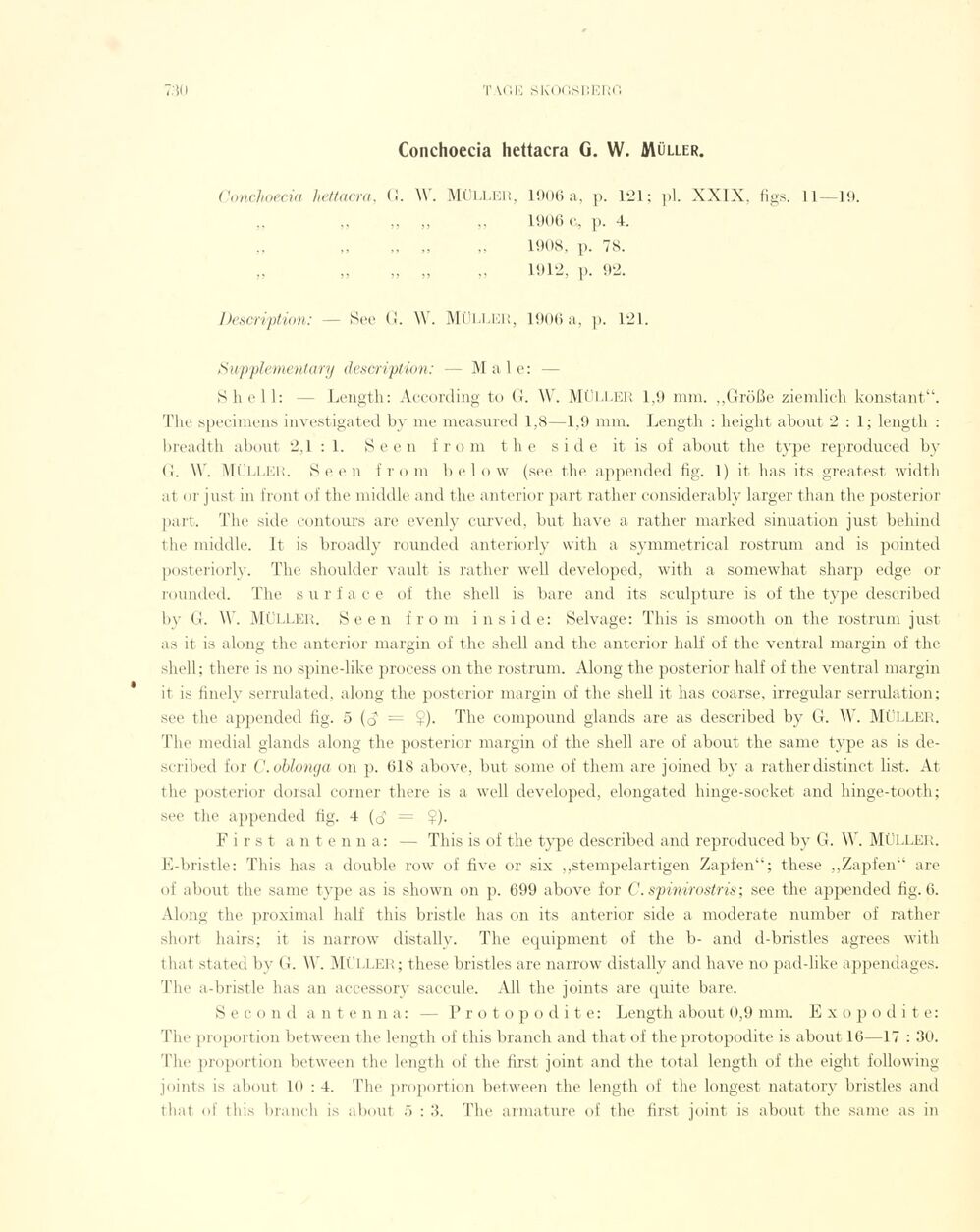
Full resolution (JPEG) - On this page / på denna sida - Sidor ...

<< prev. page << föreg. sida << >> nästa sida >> next page >>
Below is the raw OCR text
from the above scanned image.
Do you see an error? Proofread the page now!
Här nedan syns maskintolkade texten från faksimilbilden ovan.
Ser du något fel? Korrekturläs sidan nu!
This page has never been proofread. / Denna sida har aldrig korrekturlästs.
Conchoecia hettacra G. W. Müller.
Conchoecin hettacra, G. \V. MÜLLER, 1906 a, p. 121; pi. XXIX, figs. 11—19.
„ » „ „ » 1906 c, p. 4.
„ „ „ 1908, p. 78.
„ „ „ „ „ 1912, p. 92.
Description: — See (J. W. Müller, 1906 a, p. 121.
Supplementary description: — Male: —
Shell: — Length: According to G. W. MÜLLER 1,9 mm. „Größe ziemlich konstant“.
The specimens investigated by me measured 1,8—1,9 mm. Length : height about 2:1; length :
breadth about 2,1 : 1. Seen from the side it is of about the type reproduced by
G. W. Müller. Seen from b e 1 o w (see the appended fig. 1) it has its greatest width
at or just in front of the middle and the anterior part rather considerably larger than the posterior
part. The side contours are evenly curved, but have a rather marked sinua tion just behind
the middle. It is broadly rounded anteriorly with a symmetrical rostrum and is pointed
posteriori)’. The shoulder vault is rather well developed, with a somewhat sharp edge or
rounded. The surface of the shell is bare and its sculpture is of the type described
by G. W. MÜLLER. Seen from inside: Selvage: This is smooth on the rostrum just
as it is along the anterior margin of the shell and the anterior half of the ventral margin of the
shell; there is no spine-like process on the rostrum. Along the posterior half of the ventral margin
it is finely serrulated, along the posterior margin of the shell it has coarse, irregulär serrulation;
see the appended fig. 5 (d — ?). The compound glands are as described by G. W. MÜLLER.
The medial glands along the posterior margin of the shell are of about the same type as is
described for C. oblonga on p. 618 above, but some of them are joined by a rather distinct list. At
the posterior dorsal corner there is a well developed, elongated hinge-socket and hinge-tooth;
see the appended fig. 4 (d = $).
First antenna: — This is of the type described and reproduced by G. W. MÜLLER.
E-bristle: This has a double row of five or six „stempelartigen Zapfen“; these „Zapfen“ are
of about the same type as is shown on p. 699 above for C.spinirostris ; see the appended fig. 6.
Along the proximal half this bristle has on its anterior side a moderate number of rather
short hairs; it is narrow distally. The equipment of the b- and d-bristles agrees with
that stated by G. W. Müller ; these bristles are narrow distally and have no pad-like appendages.
The a-bristle has an accessory saccule. All the joints are quite bare.
S e c o n d a n t enna: — Protopodite: Length about 0,9 mm. Exopodite:
The proportion between the length of this branch and that of the protopodite is about 16—17 : 30.
The proportion between the length of the first joint and the total length of the eight folio wing
joints is about 10 : 4. The proportion between the length of the longest natatory bristles and
that of this branch is about 5 : 3. The armature of the first joint is about the same as in
<< prev. page << föreg. sida << >> nästa sida >> next page >>